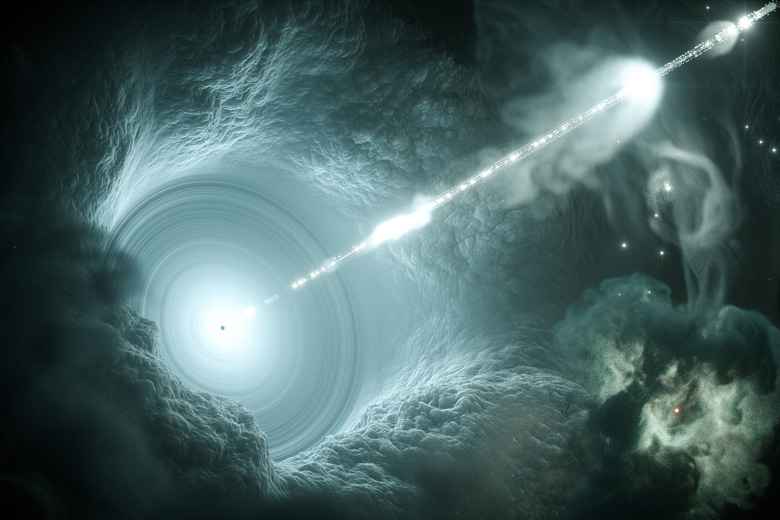Cosmic neutrinos
In 2013, IceCube detected high-energy neutrinos from the depths of space for the first time, opening a new window to the universe. It was the dawn of high-energy neutrino astronomy. Another breakthrough came just a few years later, in 2018. By comparing IceCube data with measurements from other observatories, an international team of scientists was able to spot the source of a cosmic neutrino for the first time. Their observations pointed to a supermassive black hole in the center of an active galaxy several billion light-years away.
The next generation of the IceCube observatory, IceCube-Gen2, will build on and multiply such successes: Its technology will turn such detections into a measurement standard in the future. This will revolutionize our understanding of the high-energy universe over the next decade.
A unique source of information
Neutrinos can originate from regions of space where light cannot reach us. They can be produced in cosmic particle accelerators, such as the jets of massive black holes or exploding stars. In such environments, they arise along with the electrically charged atomic nuclei of cosmic particle radiation that constantly bombards Earth. In contrast to these atomic nuclei, however, the electrically neutral neutrinos are not deflected by cosmic magnetic fields on their way through space. Their direction of arrival points directly to their source. Neutrinos can therefore be key to a deeper understanding of these cosmic particle accelerators and of the origin of cosmic rays.

Artist's impression of a Blazar (Credit: DESY, Science Communication Lab)
Multimessenger observations
IceCube-Gen2 will further advance the highly dynamic field of multimessenger astronomy, the simultaneous observation of cosmic phenomena with the help of various “messengers” such as light, neutrinos, and gravitational waves. To decipher the physical nature of neutrino sources, it is crucial to detect a high number of neutrinos at high energies, with high precision in order to be able to point other observatories in the direction of possible sources.
Research in Germany and Europe is very well positioned in the field of multimessenger astronomy. IceCube-Gen2 will shape the field of neutrino astronomy for decades to come. The project complements a network of current and future large-scale observatories that are investigating gamma radiation, gravitational waves, cosmic rays, and neutrinos. In addition to IceCube-Gen2, this includes the Cherenkov Telescope Array (CTA) for gamma radiation and the planned Einstein telescope for gravitational waves. Together, these observatories will allow for unprecedented insights into the most energetic processes in the universe.
NEWS 07/20
Searching for neutrinos from gravitational-wave events
IceCube scientists are specifically searching for neutrino emissions from gravitational wave events. In 2017, a gravitational wave signal was recorded for the first time from merging neutron stars. Following the signal, other telescopes and observatories around the world detected the same source in visible light, gamma rays, ultraviolet light, X-rays, and radio waves. For the first time, it was possible to correlate gravitational waves with electromagnetic radiation. A new era of multimessenger astronomy had begun. The successful detection of neutrinos from gravitational wave events would be a true breakthrough.
